Your New Sci-Fi Heroine: Ruby, The Galactic Gumshoe
 |
There are plenty of powerful, exciting, interesting female leading characters throughout all of sci-fi. James Cameron provided us with about half of them, Joss Whedon gave us a small number more, and we do occasionally get an exciting and roguish female lead otherwise. The fact remains, however, that leading female characters in sci-fi, fantasy, and other geek-oriented genres are much thinner on the ground than their copious (and copiously popular) male counterparts.
For those frustrated by this general gender imbalance (and I know you’re out there), or are perhaps a little put off by writers’ tendency make their female characters “stronger” merely by putting guns and swords into their hands (hello, Freud), I would like to introduce you to you new favorite sci-fi heroine: Ruby, The Galactic Gumshoe.
Ruby might be a tough sell for most people, as her medium is perhaps a little less popular than some of its visual counterparts; Ruby is the heroine of a series of audio adventures, both serialized and long-form. And I think it’s time for us to embrace audio drama. In this modern age of podcast ubiquity (Topless Robot has a podcast now, and I’m sure you’re all listening, right?), I’m surprised that scripted audio drama has not caught on in a big way. I invite you to check out Ruby as your introduction not just to an awesome character, but to the medium in general.
Ruby (sometimes called Ruby Tuesday, but mostly just known by her first name) was created in the early 1980s by Tom Lopez, the founder of The ZBS Foundation, a radio drama collective based in New York that goes all the way back to 1970 and is still in active business today. Ruby is a sassy, strong, wiseass, occasionally mean, never soft, downright dynamic woman who works as a private detective in the distant future. In said future, the Earth has been bought by Disney and transformed into a planet-sized theme park, so most humans have moved to the planet of Summa Nulla, translated literally as “the summit of nothing.” Ruby (voiced by actress Laura Esterman) is often joined by a trio of trusted compatriots throughout her adventures, including the horny, sex-bot-obsessed archeologist T.J. Teru (Bill Raymond), the pure-hearted Tesla-worshiping techie And/Or (Art Fairbain), and the sniveling half-rat Rodant Kapoor (also Fairbain).
Ruby is an awesome character. She’s tough and sarcastic. She takes very little seriously, has a definite penchant for violence (she never goes anywhere without an enormous arsenal of bizarre hidden weapons), and she has the uncanny (and never-explained) superpower of being able to slow time for brief periods. So we have a kickass noir PI living in the future, blasting away at lizard assassins, ducking bullets with her superpowers, always astutely and sarcastically observing that people are way too screwed up for their own good. If I haven’t sold it yet, you require a lot. But read on.
The Ruby adventures have intriguing stories, lots of wonderfully lame puns, and tend to feature an anti-establishment bent. Most of the stories are sharply critical of mass media and consumer culture, and how pervasively the media controls one’s mind. Indeed, one of the Ruby stories is about an evil interdimensional god who is causing a city-sized supermall to grow and mutate take over the surface of Summa Nulla.
Ruby has starred in nine long-form adventures to date, and a few short adventures throughout. Here is a brief rundown on each:
Ruby: The Adventures of a Galactic Gumshoe (1982)
 |
In the original Ruby adventure, our intrepid heroine is hired by Rodant Kapoor to find out who has been manipulating the media on her home planet. Ruby eventually finds a conspiracy about the insidious co-opting of human consciousness, as well as a plot hatched by the Slymies, a team of bio-engineered assassins. It’s whip-smart, fast paced, features some great acting and a lot of awesome electronic music.
Ruby 2: The Further Adventures of a Galactic Gumshoe (1985)
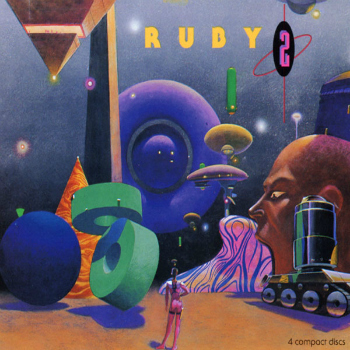 |
You may want to skip straight to part three, as Ruby 2 was rushed into production with a new character in the lead, Ruby Too, and a story that is near impossible to follow. I recommend that you listen to two or three other Ruby adventures before getting to this oddball slapstick farce about the imposing species of The Bulldada, and their attempts to track down the masterminds behind the force that is spying on them through their very brains.
Ruby 3: The Underworld (1990) and Ruby 3: The Invisible World (1991)
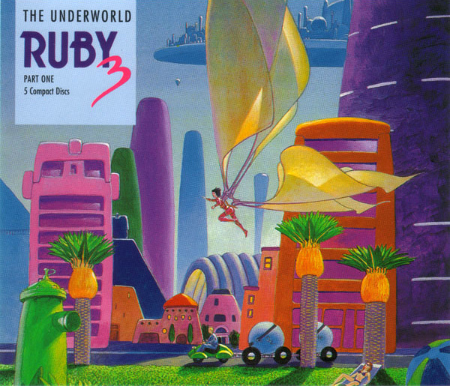 |
In this ten-hour epic, Ruby is investigating that pesky interdimensional god Zum Zamim, and wants to know why this evil god has been causing the planet’s giant mall to grow and grow. What is it about consuming that feeds this evil god? Eventually Ruby and her friends must travel into the Invisible World (a world made of thought) to do battle with him. In a parallel story, based on an ancient Sumerian myth, a pair of sisters do battle for dominance over The Underworld, the dark side of the planet run by lizards and gamblers and misery.
Ruby 4 (1994 – 1995)
 |
In what is perhaps the most straightforward and largest of the Ruby stories, Ruby seeks the origin of mysterious coin that may have been minted on a moon that may or may not exist. In her quest, she finds that evil Reptoids from the seventh dimension (perhaps a reference to the Red Lectroids from the 8th dimension from Buckaroo Banzai) have been feeding off of humans’ negativity. This dimension-hopping epic is about 8 hours in length, and worth every wonderful, funny, exciting minute. I also love the appearance of Fran?ois, the French robot waiter.
Ruby 5: The Land of Zoots (1998)
 |
This Ruby adventure only runs about 2 ? hours, and tells the story of a blissful archipelago on Summa Nulla that seems to be transforming itself into a whimsical Oz-like land called The Land of Zoots. Ruby is hired to find out why the inhabitants are doing it, and how their new cartoon utopia may pose a threat to the rest of the planet’s media moguls.
Ruby 6: The Illusionati (2001)
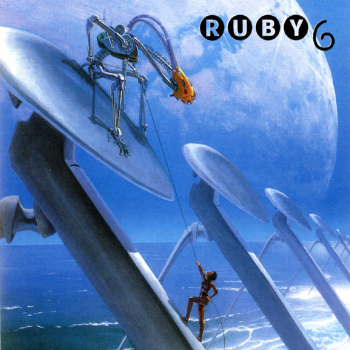 |
On a planet called Illubu Roi (a reference to the 1896 absurdist play by Alfred Jarry), the inhabitants are happy. They live in balance with nature, and they rarely invite outsiders to their homeworld. Ruby is hired by an Illubu to investigate a secret society called The Illusionati who may be undermining Illubu society. Ruby is sneaked onto the planet, and becomes enamored of the unusual empathic denizens. And, of course, the conspiracy is very real.
Ruby 7: Dream Weaver, Dream Deceiver (2006)
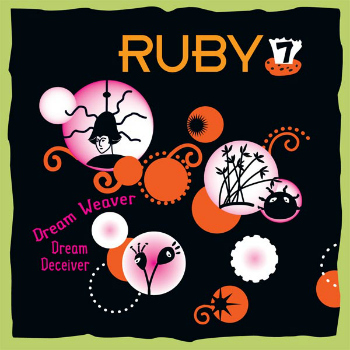 |
On a planet called M?bius-Morpheus, the citizens all think they’re living in a dream. Ruby is hired by the government to find out why the citizens, usually so placid, are experiencing fear for the first time. And why would someone want to make a whole populace fearful? Might it have something to do with the evil clown Cream Puff? The story is kind of weak on this one, but the puns and creative settings and awesome music are still in full force.
Ruby 8: The Good King Kapoor (2009)
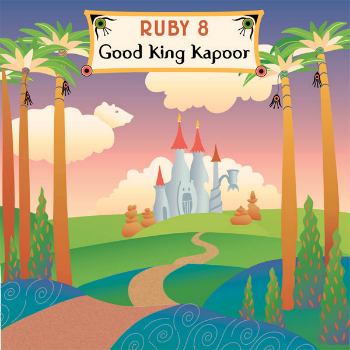 |
Rodant Kapoor, Ruby’s sniveling and annoying rat-like friend, has had enough of his nagging mother, and has decided to escape to another dimension. Ruby is eventually hired by Mother Kapoor to seek out Rodant thanks to a special dimension-hopping machine called The Rapturizer. She eventually finds that Rodant has become king of an alternate dimension, a dimension ruled by peace and tranquility. Can Ruby and her compatriots keep this pure dimension from being tainted by their own very human fears and desires?
Ruby 9: Masque of the Red Moon (2011)
 |
A distant moon has decided that they want to cosplay as steampunk Victorians 24 hours a day. Ruby is hired to infiltrate (and dress as members of) this mannered fantasy society as Lady Windermere. Is the constant roleplay doing damage to the planet, or are the fantasies we have, and the masks we wear, a way of escaping the overwhelming encroachment of media banality? This one has a complex message that can be discussed and debated.
All of the Ruby shows are currently available for download (and on discounted CDs) through ZBS.org, and you can find some of them on sites like Audible and Amazon.
These are wonderfully imaginative stories, some of which could never possibly be filmed (how does one film an Invisible World for example?), making their audio format unique and striking. The casts are excellent throughout, the plays move along with a zippy pace. Also, their cheesy sense of humor can appeal to gobsmacked little kids and bitter adults alike. The new audio drama renaissance may be nigh, so I’d like to give you a leg up on some of the best audio dramas out there. You could do much worse than to start with Ruby.
Previously by Witney Seibold
TR’s 10 Worst Nerd Films of 2014
12 Reasons Why I Should Direct the Next Star Trek Movie
